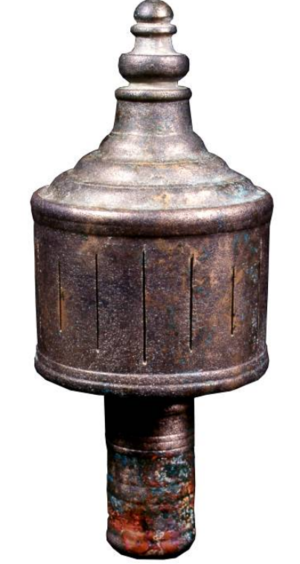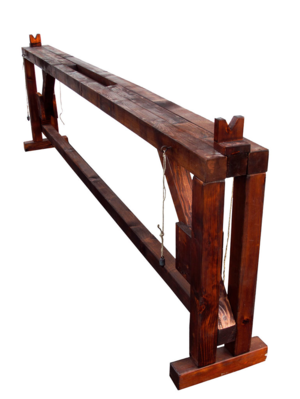The Romans - Masters of all they surveyed
Blog by Emily Pierce, PLS, CFedS
Surveyors have been doing their job for millennia, and the ingenuity (and accuracy) of ancient instruments is mind-boggling. My last blog was focused on the surveyors of ancient Egypt, who were responsible for laying out temples, palaces, pyramids, boundaries for the Pharaoh to be able to levy taxes accurately.
Let’s spring forward several centuries – to ancient Rome. As we all know, the Romans were prodigious builders – not only of empires, but of roads, military garrisons, palaces, temples, baths, aqueducts and more.
Roman engineering features extremely precise measurements and procedures they learned from the Greeks – starting with Pythagoras (approx. 570-500 BCE). Although he is credited with the Pythagorean Theorem, some indications of that theorem have been found on Babylonian tables from 1900-1600 BCE.
Pythagoras was more than a mathematician – he founded a philosophic school. Students were sworn to secrecy and took part in many religious rituals that included dietary restrictions and self-discipline. This school explored the fate of the soul after death and applied mathematical principles to astrology. Not much is really known about Pythagoras (probably due to all the secrecy) – historians doubt that he wrote any books. Anyway, the theorem attributed to him is used in many subsequent books including Euclid’s (365-300 BCE) treatise on geometry - “Elements.”
It wasn’t just the Greeks who were busy with math and surveying. Thanks to the work of the Egyptians, Babylonians and Greeks, the Romans were able use geometry and existing surveying instruments to develop the tools that helped them create awe-inspiring structures that have withstood the test of time.
Here’s a list of their likely tools:
14 June 2008 MatthiasKabel Photographed during "Römerfest" 2008 in Carnuntum
String – like the Egyptians, the Romans treated their strings or ropes with a mixture of wax and resin, then weighted and suspended them for a specific period of time. This resulted in strings that could maintain their length without distortion. Some sources believe Romans also used chains, though there’s no specific documentation of that.
Decempeda or pertica (perch) – a wooden rod, approximately 16 and a half feet long, treated to prevent deformation. Yes, the rod unit of measure we still use today was actually based on a real rod.
Odometer – A system of cogs inside a box that engaged with another set of cogs placed in a very precisely constructed cart wheel. For every mile the cart (or ship) traveled, a pebble would drop into a container. The Roman military engineer, Vitruvius, describes this device. (I wonder if this is where all the pebbles in my car come from - couldn’t be the dog!)
Range poles – Groups of three vertical poles that would follow a straight line, then extend the line by bringing the first pole to the front. They were often used in conjunction with other surveying instruments such as the groma.
Groma – This is a cross with arms at right angles, at the end of which has plumb lines, and a vertical foot to adjust this combination in a horizontal plane. A prominent Roman civil engineer, water commissioner, author, soldier and senator (40-103 AD) named Sextus Julius Frontinus describes the Groma as follows:
“Every part of a field no matter how small should be in the power of a surveyor and subject to his requirements in terms of right angle procedures. The groma should be used firstly to align all the obstacles in line with the alidade. Its lines or strings drawn taut by bobs, and parallel with each other, can be seen well from all the corners, until only the nearest can be seen, with the other out of sight. Then fix ranging poles, again setting the sight on them, when the groma has meanwhile been taken to the last ranging pole in its same position and prolong the line that has been started to the corner or to the boundary. The right angle from any corner on the perimeter determines the position of the groma.”̶ Frontinus, Del limitibus, 32, 33.
Speaking of Frontinus, there’s a society dedicated to his work “Frontinus-Society” based in Bonn, Germany. They’re having a conference in Sept 2022, focusing on the Roman baths built in Budapest.
Like the Egyptians using the Rope-Stretcher, the use of the groma was likely part of a religious ritual. You can see its importance as it has been found on ancient walls in bas relief as well as on the tombstone of Aebutius Faustus, a “priest surveyor” from Ivrea (part of Turin in northwestern Italy).
Surveyor’s Square - Apparently, one actual instrument was dug up in an archeological dig and housed in a German museum in Koblenz. Unfortunately, after or during WWII, the item was lost. A description of the Square was included in a book written about Frontinus by Klaus Grewe in 1985 that includes a drawing.
A second Surveyor Square was found in 1997 in the ruins of a Roman villa near Amiens in France. Some tests were done on the French version and it was found that the viewpiece (x) was just 0.6 mm wide, which means that at a distance of 50 meters, the field of vision is only 39 cm. It seems to be a very precise instrument for line of sight.
Of the two surveyor’s squares mentioned, the more accurate version was actually the missing Koblenz version. Even though all of its faces had wider gaps for sights, reference cords would have been fixed on them, providing greater accuracy. This also allowed users the ability to re-calibrate the cords.
Drawing of the Roman Surveyor’s square included in a book by Klaus Grewe in 1985.
Drawing of the French Surveyors Square. Marchand, g., Petitot, H, Vidal, L 2000: Le’equerre d’arpenteur de l’Orme a Ennemain (Somme).
A reconstruction of the Chorobates.
The Chorobates - This is a leveler that was used in all the great water works built by the Romans. A physical example of the device has not been found, but it has been described in ancient writings, particularly those by Vitruvius, another famous Roman author, architect, civil and military engineer that lived from about 80 BC to 15 BC. Below is a reproduction.
Here’s what Vitruvius said about it. “The Chorobates is a rule about twenty feet long. It has elbows at both ends constructed in the same fashion. They are fixed at right angles to the ends of the ruler.
Between the ruler and the elbow are hinged struts. The struts have vertical straight lines marked on them as well as plumb-lines hanging from the ruler. When the ruler is positioned and plumb-lines touch the inscribed lines precisely and simultaneously, the leveling is established.
However, if the wind interferes, there’s a channel in the upper section about five feet long, an inch wide and about one and a half inches deep full of water. If the water touches the upper parts of the channel, it can be leveled, and the degree of the slope is found.”
Heron of Alexandria’s Diopter
The Diopter - This device is essentially an alidade, or sight line, with slots that can be moved or horizontally pivoted on a graduated limb. Originally developed by the Greeks, it was used extensively by the Romans for surveying. The most simple design is a disk, engraved with two diameters at right angles which the alidade would rotate horizontally within, and would be carried on a sighting bar that would pivot at its center. It could also be suspended on an edge by a ring or by aligning the alidade with the horizontal axis.
The drawing to the left is based on Heron of Alexandria’s (Greek Mathematician 10 AD – 70 AD) description of the device: It’s a very simplistic version of a transit or theodolite and was used extensively on aqueduct building projects.
These instruments show us that there’s really nothing new under the sun …we use the same basic concepts of sights, level lines, and angles still today. All of the instruments we use today are based on mathematics – the same basis the Romans used to survey their building projects.
It’s those mathematics that we should all understand and respect as surveyors, so that the next time we’re out in the field, and our batteries die in the data collector, we can still continue to get the job done.
References:
http://www.surveyhistory.org/roman_surveying1.htm
http://www.romanaqueducts.info/technicalintro/surveyingtools.htm








